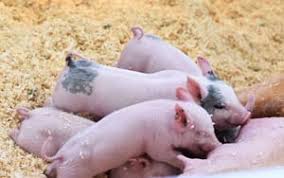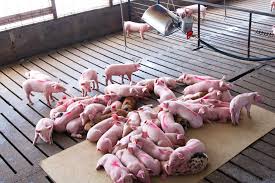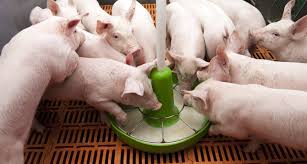Early weaning in pigs is the practice of separating piglets from their mothers at a younger age, typically around 21 to 28 days, rather than the conventional weaning age of six to eight weeks.
This method has gained popularity in modern pig farming due to its multiple advantages, particularly in commercial operations where maximizing productivity is essential. While early weaning requires careful management to ensure the health and development of piglets, it offers significant benefits that can improve overall herd performance, disease control, and farm profitability.
One of the key advantages of early weaning in pigs is improved disease control. By weaning piglets earlier, farmers can reduce the transmission of diseases from sows to their offspring, particularly in cases where certain pathogens may be passed through milk or close contact. In large-scale pig farming operations, disease outbreaks can lead to substantial economic losses.
Early weaning, combined with proper sanitation and biosecurity measures, helps limit the spread of infections, ensuring healthier piglets and reducing the need for medical interventions.
Another benefit is enhanced sow productivity. Early weaning allows sows to recover more quickly and return to estrus sooner, which shortens the interval between litters. This enables farmers to increase the number of litters per sow per year, boosting overall production levels.
For farms focused on maximizing output, this increased reproductive efficiency can translate into higher profits, as more piglets are produced over a shorter period.
Additionally, early weaning promotes more efficient growth in piglets. When piglets are weaned earlier, they can be transitioned to solid feed, particularly nutrient-dense starter feeds designed to meet their specific dietary needs. This can lead to faster weight gain and more uniform growth among piglets.
Early weaning also allows for better control over the nutritional intake of each piglet, ensuring they receive the right balance of nutrients needed for optimal development, which may not always be achievable when they are nursing from the sow.
Another important advantage of early weaning is the opportunity for improved piglet management. Piglets can be grouped by size and health status after weaning, allowing farmers to provide specialized care for weaker or smaller piglets.
This grouping can help prevent competition for resources and enable more precise feeding strategies, further supporting growth and health outcomes.
In the long run, this individualized approach to care can lead to stronger, healthier pigs that are better suited for commercial production.
Finally, early weaning can reduce stress on sows. Lactating sows experience significant physical demands while nursing large litters, and early weaning reduces this burden, allowing them to regain body condition more rapidly.
This, in turn, enhances the sow’s overall health and reproductive performance, leading to longer productive lifespans and better outcomes for future litters.
Improved Growth Performance

1. Accelerated Weight Gain: Early weaning encourages faster growth in piglets by introducing solid feeds sooner, which promotes early development of the digestive system. Piglets weaned early are more likely to gain weight rapidly compared to those weaned later.
2. Reduced Competition for Milk: As piglets are weaned earlier, they no longer compete for the sow’s milk, ensuring they receive balanced and consistent nutrition from feed. This uniformity in nutrition helps standardize growth rates across the litter.
3. Optimized Space for New Litters: Weaning piglets early allows the sow to return to reproductive readiness more quickly, enabling the farm to accommodate more frequent litters. This increases overall productivity, which is a key goal in intensive pig farming systems.
Enhanced Feed Efficiency
1. Better Utilization of Nutrients: Early-weaned piglets have a greater capacity to efficiently utilize nutrients from specially formulated starter diets. These diets are designed to provide the necessary vitamins, minerals, and proteins that support rapid growth and development.
2. Reduced Feed Waste: With controlled feeding in the early stages of weaning, there is less wastage of feed, as piglets quickly adapt to consuming solid food. This contributes to a more cost-effective feeding strategy and better feed conversion ratios.
3. Faster Transition to Grower Feeds: Early weaning also facilitates a quicker transition to grower diets, which are designed to support the next phase of growth. This efficient feed transition ensures that piglets continue to thrive as they grow.
Disease Prevention and Health Benefits
1. Reduced Risk of Sow-Transmitted Diseases: By separating piglets from the sow early, the risk of disease transmission from the mother to the piglets is minimized. This is especially important in preventing viral and bacterial infections that can severely impact piglet survival rates.
2. Controlled Environment for Piglets: Early-weaned piglets are often placed in carefully monitored environments where temperature, hygiene, and feeding schedules are controlled. This setup reduces the risk of infections and promotes a healthier start in life.
3. Stronger Immunity Through Early Vaccination: Early weaning allows piglets to be vaccinated sooner, strengthening their immune systems before they are exposed to potential pathogens. This proactive health management leads to fewer disease outbreaks and overall better herd health.
Read Also: 12 Medicinal Health Benefits of Emilia Sonchifolia (lilac tasselflower)
Reduced Mortality Rates

1. Enhanced Monitoring and Care: Early-weaned piglets are moved to specialized nursery environments where they can be closely monitored for health issues. These nurseries often have better control of temperature, sanitation, and feeding, which reduces the risk of disease, starvation, or other causes of mortality. This focused care helps ensure more piglets survive the vulnerable post-weaning period.
2. Minimized Exposure to Sow-Related Risks: Early weaning reduces the chances of piglets being injured by the sow, which can sometimes happen due to accidental crushing or aggressive behavior. By separating piglets earlier, these risks are eliminated, leading to lower mortality rates within the litter.
3. Faster Response to Health Issues: With piglets in controlled nursery conditions, farmers can detect and treat illnesses or growth problems more quickly. This timely intervention significantly reduces deaths from common piglet diseases such as diarrhea or respiratory issues.
Better Sow Recovery and Productivity
1. Reduced Lactation Burden: By weaning piglets early, sows are relieved from the physical demands of milk production sooner. This leads to faster recovery as they regain body condition, ensuring they are healthier and more productive for the next reproductive cycle.
2. Shorter Interval Between Litters: Early weaning helps sows return to estrus (heat) faster, allowing them to conceive more quickly. This increases the number of litters a sow can produce in a given time, enhancing overall farm productivity and profitability.
3. Improved Sow Longevity: By easing the burden of extended lactation, early weaning can improve the longevity of sows in the breeding program. Healthier sows with better body condition are more likely to remain productive for a longer period, reducing the need for frequent replacement of breeding stock.
Increased Litter Size Potential
1. More Frequent Breeding Opportunities: Since early weaning shortens the interval between pregnancies, sows have more opportunities to reproduce throughout their breeding lifespan. This increases the potential for more litters, ultimately leading to a higher number of piglets produced per sow over time.
2. Healthier, Larger Litters: With better body condition and recovery after each weaning, sows are more likely to produce healthier and larger litters in subsequent pregnancies. The overall reproductive performance improves, benefiting the farm’s production goals.
3. Genetic Improvement Opportunities: Increased breeding cycles also present more chances for selective breeding. Farmers can focus on selecting superior sows and boars that produce larger, healthier litters, leading to genetic improvements within the herd over time.
Improved Piglet Socialization
1. Earlier Interaction with Other Piglets: Piglets that are weaned early are introduced to other piglets sooner, promoting early socialization. This helps piglets develop social behaviors, such as establishing pecking orders and learning to interact with peers, which is important for group housing systems.
2. Reduction in Aggressive Behavior: Early socialization can reduce aggressive behaviors in later life. By learning to interact with other piglets at a younger age, they become more accustomed to sharing space and resources, leading to fewer fights and injuries as they grow.
3. Smoother Transition to Group Housing: Piglets that are socialized early tend to adapt better to group housing environments, which are common in commercial farming systems. This smoother transition reduces stress levels, which can contribute to better growth rates and overall well-being.
Enhanced Immune Development
1. Stronger Immunity Through Early Nutrition: Early-weaned piglets are introduced to specially formulated feeds that are rich in essential nutrients, vitamins, and probiotics. These nutrients promote the development of a stronger immune system, helping piglets build resistance against diseases early on.
2. Early Vaccination Benefits: Early weaning allows piglets to be vaccinated at a younger age, giving their immune systems a head start in fighting off common piglet diseases. This proactive approach helps protect against infections and strengthens their overall immunity throughout the growth period.
3. Reduced Exposure to Sow-Related Diseases: By separating piglets from the sow earlier, there is a reduced risk of them contracting diseases that could be passed from the sow. This isolation helps the piglets develop their own immune responses without being exposed to potential pathogens present in the sow’s environment.
Read Also: 13 Medicinal Health Benefits of Arum cylindraceum (tuberous wild calla)
Reduced Risk of Parasitic Infections

1. Controlled Environment for Hygiene: Early weaning often places piglets in a cleaner and more controlled environment, which significantly lowers their exposure to parasites. With proper sanitation in nurseries, the risk of parasitic infections like worms is minimized, ensuring healthier growth.
2. Early Deworming Programs: In early-weaning systems, piglets can be introduced to deworming treatments at an appropriate time, further reducing the risk of parasitic infestations. This helps in maintaining their health and prevents growth retardation caused by parasites.
3. Less Contact with Contaminated Environments: Early weaning reduces the time piglets spend in potentially parasite-laden areas where the sow is kept. By moving them into a controlled, parasite-free environment, the likelihood of them contracting parasitic infections is significantly lowered.
Early Market Readiness
1. Faster Weight Gain: Early-weaned piglets are introduced to solid feed sooner, which allows them to gain weight rapidly. With the right nutrition and care, these piglets grow faster and reach market weight more quickly, making them ready for sale earlier than traditionally weaned piglets.
2. Better Feed Efficiency: The early introduction of nutrient-dense feeds improves feed conversion rates, meaning piglets grow larger with less feed input. This efficient use of feed not only accelerates growth but also reduces the cost of production, leading to early market readiness.
3. Reduced Time to Finish: With early weaning, the entire growth cycle is shortened, allowing pig farmers to raise more piglets to market weight in less time. This quick turnaround enables farmers to increase their output and meet market demands more efficiently.
Efficient Use of Housing and Resources
1. Increased Turnover of Nursery Space: Early weaning enables pig farmers to move piglets to nurseries sooner, freeing up space in farrowing units for new litters. This more efficient use of housing resources helps farmers increase the number of piglets they can raise in a given period.
2. Optimized Resource Allocation: By transitioning piglets to a controlled environment early, farmers can allocate resources such as feed, space, and labor more efficiently. This improves overall farm management and reduces costs associated with overcrowding or overextended facilities.
3. Maximizing Sow Productivity: Early weaning helps sows return to breeding readiness more quickly, allowing for more frequent litters and increased piglet production. This optimizes the use of both sow housing and farrowing facilities, contributing to a more profitable and sustainable farming operation.
Do you have any questions, suggestions, or contributions? If so, please feel free to use the comment box below to share your thoughts. We also encourage you to kindly share this information with others who might benefit from it. Since we can’t reach everyone at once, we truly appreciate your help in spreading the word. Thank you so much for your support and for sharing!
Read Also: A Child’s Guide to Castle Grayskall Toys: The Perfect Gift for Your Little Knight or Princess

